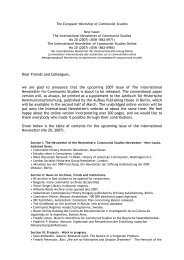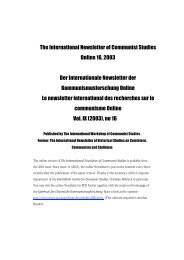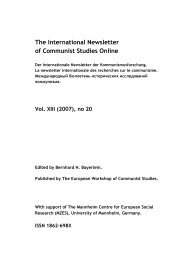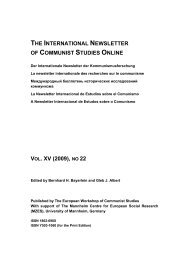VOL. XVI (2010), NO 23 - The International Newsletter of Communist ...
VOL. XVI (2010), NO 23 - The International Newsletter of Communist ...
VOL. XVI (2010), NO 23 - The International Newsletter of Communist ...
Sie wollen auch ein ePaper? Erhöhen Sie die Reichweite Ihrer Titel.
YUMPU macht aus Druck-PDFs automatisch weboptimierte ePaper, die Google liebt.
<strong>The</strong> <strong>International</strong> <strong>Newsletter</strong> <strong>of</strong> <strong>Communist</strong> Studies Online <strong>XVI</strong> (<strong>2010</strong>), no. <strong>23</strong> 33<br />
Magali Delaloye, Universität Bern (Switzerland):<br />
Gender Relationships in Stalin’s Ruling Circle. Practices and Discourses<br />
(1928-1953). PhD Project. 1<br />
Although equality between men and women was considered as established since the<br />
dissolution <strong>of</strong> zhenotdel (feminine section <strong>of</strong> the CPSU) in 1930, the Stalin regime launched<br />
several mobilisation campaigns with a gender connotation. <strong>The</strong> more visible ones concerned<br />
the many calls to women to participate in efforts <strong>of</strong> collectivisation <strong>of</strong> the countryside and the<br />
launch <strong>of</strong> a large-scale industrialisation policy, by developing, for example, the<br />
obshchestvennitsa (“female social activist”), 2 while progressively abandoning the image <strong>of</strong><br />
the female activist <strong>of</strong> the 1920’s. Parallel to this part <strong>of</strong> propaganda aimed at women, a<br />
discourse is built up <strong>of</strong> a hyper virile male model described as the soldier <strong>of</strong> socialism: the<br />
nearly systematic use <strong>of</strong> military images in these discourses creates a dynamic <strong>of</strong> a “wartime<br />
mobilisation” society. In the 1930’s, the regime’s politics, confronted by what historiography<br />
calls the “gender problem”, are therefore as varied as the feminine and masculine models,<br />
which underlie them.<br />
<strong>The</strong> role <strong>of</strong> the Kremlin Circle in setting up these policies is important, due to its central<br />
position in the Soviet system, and thus gives the impetus to start new propaganda<br />
discourses. <strong>The</strong> aim <strong>of</strong> this research is to reconstruct the power and domination relationships<br />
within Stalin’s Kremlin, especially in the “First Circle” around him, from a gender point <strong>of</strong><br />
view. My questioning concerns particularly the gender representations <strong>of</strong> the protagonists <strong>of</strong><br />
this Circle, which fuel the discourses on gender difference (prescripts). <strong>The</strong>refore, the main<br />
and most central point concerns the policies, which these discourses put into practice, modify<br />
or subvert (scripts). By employing the approach <strong>of</strong> historical anthropology, which puts family<br />
and social connections between the members <strong>of</strong> a group into its main focus, and taking into<br />
consideration the gender aspect, I am seeking to reconstruct the inter-individual links<br />
connecting these various protagonists, showing a different community structure than the<br />
results obtained by a political history analysis. From a micro-historical angle, the main point<br />
<strong>of</strong> my research consists in the analysis <strong>of</strong> the moment <strong>of</strong> crystallisation, which allows the<br />
reconstruction <strong>of</strong> the context in which the historical protagonists act. As for the Circle’s<br />
analysis, these are moments <strong>of</strong> group exclusions that lead to the reconsideration <strong>of</strong> the<br />
internal hierarchies.<br />
However, some <strong>of</strong> these exclusions can be analysed from a gender point <strong>of</strong> view which is<br />
considered here, according to Joan Scott, 3 as a relational category functioning on several<br />
levels: symbolical, normative, structural and institutional, and finally on a subjective and<br />
individual level. If gender is a central category, it is however not exclusive: it intersects with<br />
other categories (ethnic group, generation, milieu, sexuality). 4 This allows the rebuilding <strong>of</strong><br />
the mechanisms <strong>of</strong> power in the Circle and the analysis <strong>of</strong> its hierarchies. By focusing on<br />
gender, my research’s aim is to give a new dimension to the analysis <strong>of</strong> these exclusions, to<br />
1 Under the direction <strong>of</strong> Pr<strong>of</strong>. Brigitte Studer (Bern University) and Yves Cohen (EHESS, Paris).<br />
2 For obshchestvennitsa, see e.g.: Mary Buckley: <strong>The</strong> Untold Story <strong>of</strong> Obshchestvennitsa in the 1930s. In: Europe-<br />
Asia Studies 48 (1996), 4, pp. 569-586.<br />
3 Joan Wallach Scott: Gender: A Useful Category for Historical Analysis. In: <strong>The</strong> American Historical Review 91<br />
(1986), 5, pp. 1053-1072.<br />
4 Gudrun-Axeli Knapp: Achsen der Differenz. Gesellschaftstheorie und feministische Kritik 2, Münster,<br />
Westfälisches Dampfboot, 2003. Cornelia Klinger, Gudrun-Axeli Knapp, Birgit Sauer (eds.) : Achsen der<br />
Ungleichheit. Zum Verhältnis von Klasse, Geschlecht und Ethnizität, Frankfurt am Main, Campus Verlag, 2007.














